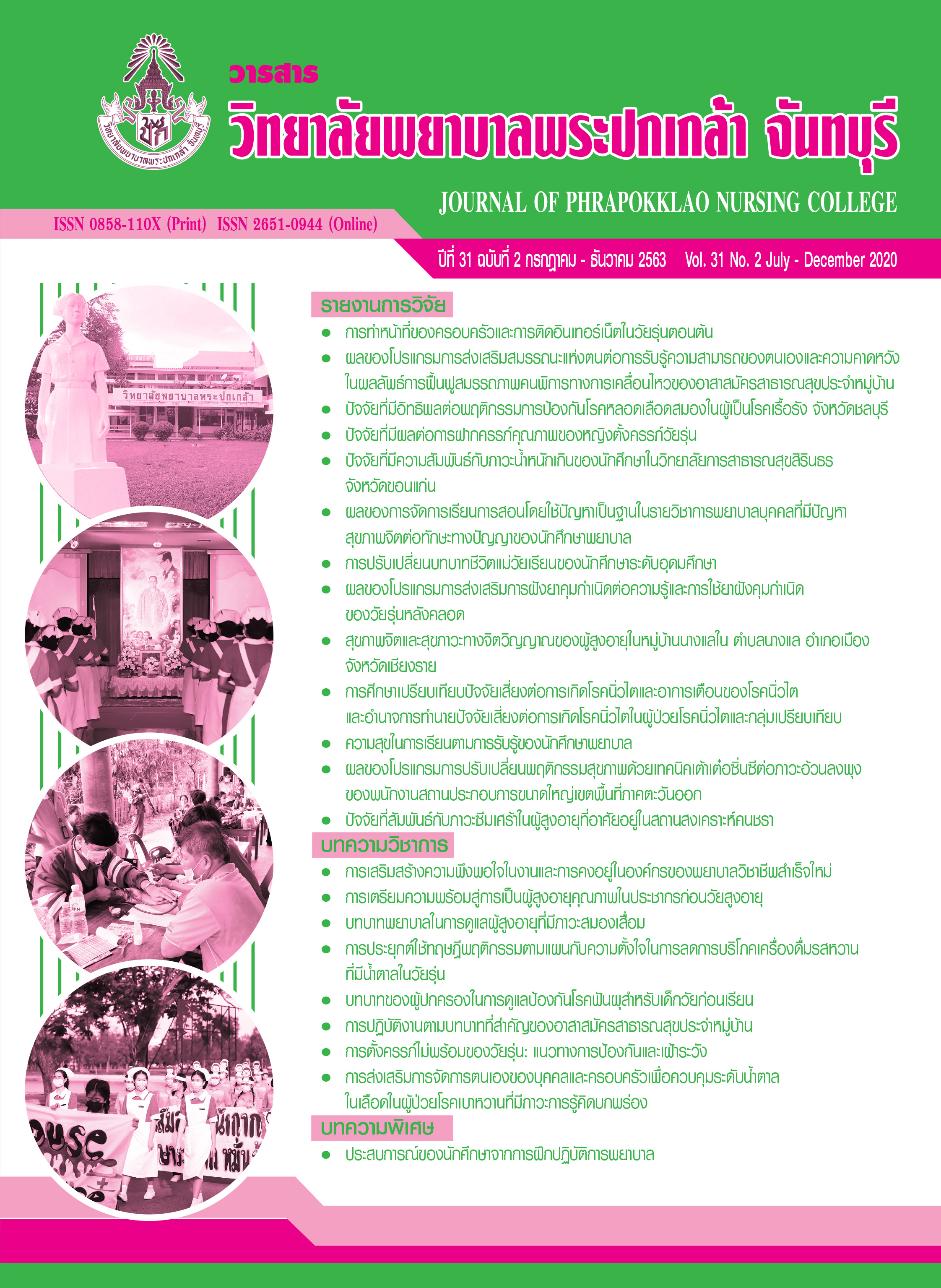Factors Influencing Preventive Behaviors for Cerebrovascular Disease among People with Chronic Disease in Chon Buri
Keywords:
Preventive behaviors, Cerebrovascular disease, People with chronic diseaseAbstract
This predictive correlational research aimed to examine the preventive behaviors for cerebrovascular disease and its predicting factors among people with chronic disease. The samples consisted of 208 people with chronic disease who received care services in the non-communicable disease clinic, subdistrict health promoting hospitals in Chon Buri. The research instrument was a four-part questionnaire including personal factors, perceived of cerebrovascular disease with the reliability in the range of .87–.95, received information with the reliability of .89, and preventive behaviors for cerebrovascular disease with the reliability of .90. Data were collected from December, 2018 to January, 2019. Statistics used for data analysis included frequency, percentage, mean, standard deviation, and stepwise multiple regression analysis.
The research results revealed that perceived benefit of prevention, perceived barrier of prevention, and received information were statistically significant accounted for 22.40% of the variance of preventive behaviors for cerebrovascular disease (R2 = .224, p < .001). The most significant predicting factor was perceived barrier of prevention (Beta = -.340, p < .001) followed by received information (Beta = .230, p < .001) and perceived benefit of prevention (Beta = .190, p < .01), respectively.
This research suggests that health care providers should apply these research results as a guideline for promoting an appropriate preventive behaviors for cerebrovascular disease among chronic disease patients by assessing perceived barrier of prevention, enhancing received information, and indicating the benefits of preventive behaviors practice.
References
กรมควบคุมโรค. (2560). รายงานประจำปี 2560. กรุงเทพฯ: สำนักงานกิจการโรงพิมพ์ องค์การสงเคราะห์ทหารผ่านศึกในพระบรมราชูปถัมภ์.
กันยารัตน์ อุ๋ยสกุล, และชนกพร จิตปัญญา. (2555). ปัจจัยที่สัมพันธ์กับความตระหนักรู้เกี่ยวกับโรคหลอดเลือดสมองของผู้ป่วยโรค ความดันโลหิตสูงในภาคใต้ ประเทศไทย. วารสารพยาบาลตำรวจ, 4(1), 15–26. สืบค้นจาก https://www.tci-thaijo.org/index.php/policenurse/article/view/23384/19956
ทิพวรรณ์ ประสานสอน. (2556). ความสัมพันธ์ระหว่างการรับรู้การเกิดโรคและพฤติกรรมการป้องกันโรคในบุคคลที่เสี่ยงต่อการเกิดโรคหลอดเลือดสมองเฉียบพลัน. วารสารสมาคมพยาบาลฯ สาขาภาคตะวันออกเฉียงเหนือ, 31(2), 36–43. สืบค้นจาก https://www.tci-thaijo.org/index.php/jnat-ned/article/view/15381/14065
ปรารถนา วัชรานุรักษ์. (2560). ปัจจัยที่มีอิทธิพลต่อพฤติกรรมการป้องกันโรคในผู้ป่วยกลุ่มเสี่ยงโรคหลอดเลือดสมอง จังหวัดสงขลา. วารสารเครือข่ายวิทยาลัยพยาบาลและการสาธารณสุขภาคใต้, 4(1), 217–233. สืบค้นจาก https://www.tci-thaijo.org/index.php/scnet/article/download/74883/60405
วาสนา เหมือนมี. (2557). ปัจจัยที่มีอิทธิพลต่อพฤติกรรมการป้องกันโรคหลอดเลือดสมองของผู้ป่วยโรคความดันโลหิตสูง อำเภอบางระกำ จังหวัดพิษณุโลก. วารสารการพยาบาลและสุขภาพ, 9(2), 156–165.
สำนักงานสาธารณสุขจังหวัดชลบุรี. (2560). กลุ่มรายงานมาตรฐาน การป่วยด้วยโรคไม่ติดต่อที่สำคัญ. สืบค้นจาก http://hdc2.cbo.moph.go.th/hdc/main/index_pk.php
สำนักนโยบายและยุทธศาสตร์ กระทรวงสาธารณสุข. (2560). สถิติสาธารณสุข 2560. นนทบุรี: ผู้แต่ง.
สุทัสสา ทิจะยัง. (2557). ปัจจัยที่มีอิทธิพลต่อพฤติกรรมการป้องกันโรคในผู้ป่วยกลุ่มเสี่ยงโรคหลอดเลือดสมอง (วิทยานิพนธ์ปริญญามหาบัณฑิต). นครปฐม: มหาวิทยาลัยคริสเตียน. สืบค้นจาก http://library.christian.ac.th/thesis/document/T035797.pdf
อรุณี สมพันธ์, แสงทอง ธีระทองคำ, นพวรรณ เปียซื่อ, และสมนึก สกุลหงส์โสภณ. (2558). ปัจจัยทำนาย พฤติกรรมการป้องกันโรคเบาหวานในผู้ที่เสี่ยงต่อเบาหวาน. รามาธิบดีพยาบาลสาร, 21(1), 96–109.
Becker, M. H. (1974). The health belief model and personal health behavior. Thorofare, NJ: Charles B. Slack.
Harmsen, P., Lappas, G., Rosengren, A., & Wilhelmsen, L. (2006). Long-term risk factors for stroke: Twenty-eight years of follow-up of 7457 middle-aged men in Goteborg, Sweden. Stroke, 37(7), 1663–1667.
Lemeshow, S., Hosmer, D. W., Klar, J., & Lwanga, S. K. (1990). Adequacy of sample size in health studies. Chichester: John Wiley & Sons.
Stamler, J., Vaccaro, O., Neaton, J. D., & Wentworth, D. (1993). Diabetes, other risk factors, and 12-yr cardiovascular mortality for men screened in the multiple risk factor intervention trial. Diabetes Care, 16(2), 434–444.
World Stroke Organization. (2014). Annual report 2014. Retrieved from https://www.world-stroke.org/assets/downloads/WSO_Annual_REPORT_2014.pdf
Downloads
Published
How to Cite
Issue
Section
License
Copyright (c) 2020 JOURNAL OF PHRAPOKKLAO NURSING COLLEGE

This work is licensed under a Creative Commons Attribution-NonCommercial-NoDerivatives 4.0 International License.
เนื้อความ ข้อมูล และรายการอ้างอิงที่ผู้เขียนใช้ในการเขียนบทความเพื่อลงตีพิมพ์ในวารสารวิทยาลัยพยาบาลพระปกเกล้า จันทบุรี ถือเป็นความคิดเห็นและความรับผิดชอบของผู้เขียน คณะผู้จัดทำวารสารไม่จำเป็นต้องเห็นพ้องด้วยหรือร่วมรับผิดชอบ
บทความที่ได้รับการลงตีพิมพ์ในวารสารวิทยาลัยพยาบาลพระปกเกล้า จันทบุรี ถือเป็นลิขสิทธิ์ของวารสารวิทยาลัยพยาบาลพระปกเกล้า จันทบุรี หากหน่วยงานหรือบุคคลใดต้องการนำส่วนหนึ่งหรือทั้งหมดของบทความไปเผยแพร่ต่อเพื่อวัตถุประสงค์ใด ๆ จะต้องได้รับอนุญาตจากบรรณาธิการวารสารก่อน



